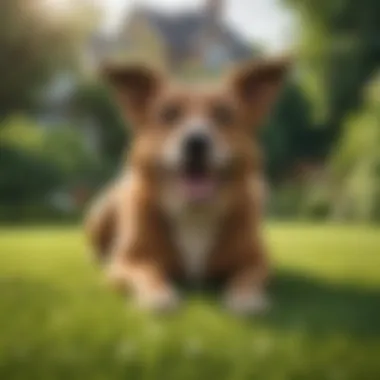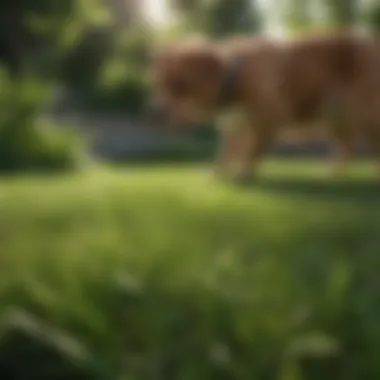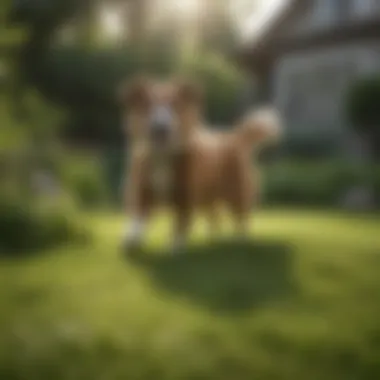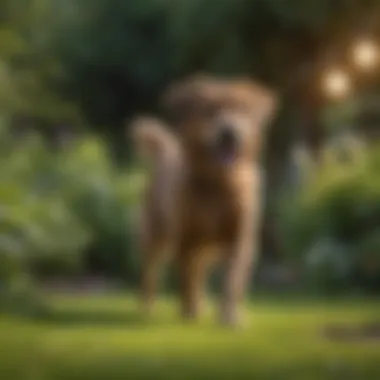Maintaining a Beautiful Lawn with Dogs: Strategies for Success


Intro
Maintaining a beautiful lawn is a challenge many pet owners face. Dogs bring joy and companionship, but their presence can lead to substantial wear and tear on a garden. This article addresses the complexities of balancing lawn care with the needs of dogs. It covers effective strategies that allow both the outdoor aesthetics and your pets’ well-being to flourish.
Understanding the interplay between pets and landscaping is crucial for homeowners. The goal is not just to keep the lawn looking good but to create a harmonious outdoor space that accommodates canine activities. By employing certain strategies and tips, homeowners can work towards achieving a vibrant lawn that remains intact despite the playful antics of their dogs.
Key Challenges
Dogs enjoy digging, running, and playing, which often leads to bare spots, muddy patches, or even a complete lawn disaster. Additionally, their toileting habits can wreak havoc on grass, leaving unsightly yellow marks. It’s essential to recognize these challenges upfront to devise appropriate solutions that will keep both your dogs and lawn happy.
Through this article, we will explore practical tips for preventing lawn damage, selecting durable grass types, and effective training strategies that harmonize dog behavior with lawn care practices. The need for a beautiful lawn does not have to conflict with dog ownership. Instead, through thoughtful planning and management, these goals can be very well aligned.
Understanding the Challenges
Creating a lush and appealing lawn while accommodating dogs presents unique challenges for pet owners. It is essential to recognize these challenges to develop effective strategies for maintaining a healthy and beautiful outdoor space. By understanding the intersection of dog behavior and lawn care, homeowners can tailor their approaches to keep both their lawn in optimal condition and their pets happy.
Common Issues Faced by Dog Owners
Pet owners often encounter various problems when trying to balance the needs of their dogs and the aesthetics of their lawns. One of the most prevalent issues is the formation of brown spots. These unsightly patches are often a result of urine exposure, which can lead to nitrogen burn in grass. Additionally, dogs can contribute to lawn wear and tear due to running, digging, and playing, all of which can compact soil and affect grass growth.
Another common issue is the presence of feces, which can damage the grass if not promptly cleaned up. This can lead to bacteria build-up, affecting both lawn health and overall pet hygiene. Moreover, certain dog breeds tend to have more energetic behavior, which can exacerbate these problems, leading to more severe lawn degradation.
Recognizing these challenges ensures that homeowners are better prepared to implement mitigation strategies, thus preserving lawn aesthetics while providing a safe environment for their dogs.
Impact of Dog Activity on Lawn Health
The activity of dogs plays a significant role in lawn health. High-traffic areas often experience compaction, making it difficult for grass to breathe and absorb nutrients. This is particularly noticeable in spots where dogs frequently run or play. Compacted soil can lead to poor drainage and may foster conditions for weeds to thrive, which can further detract from the lawn's appearance.
Moreover, the types of grass that flourish in a typical suburban lawn may not withstand the rigors of regular dog activity. Some grasses are simply not suited for heavy foot traffic, resulting in patches of dead or thinning grass over time. The interplay of these factors can create a cycle of deterioration if not effectively managed.
Addressing these impacts requires an understanding of appropriate lawn care techniques. Homeowners must consider dog behavior along with lawn maintenance practices to foster an environment that supports both a vibrant lawn and happy pets.
Choosing the Right Grass
Choosing the right grass is crucial for dog owners who want to maintain a beautiful lawn. The aesthetic appeal of a well-kept yard can enhance the overall appearance of one’s home, but this becomes complicated when dogs are present. Selecting appropriate grass types takes into account their durability, resilience, and the overall compatibility with canine activities. A well-chosen grass variety can minimize damage, reduce maintenance needs, and create an inviting outdoor space for both pets and human residents.
Durable Grass Varieties for High Traffic
When considering grass for homes with dogs, it is essential to opt for varieties that can withstand wear and tear. Some grass types are more resilient to heavy foot traffic and can recover better from damage caused by playful dogs. For instance, Perennial Ryegrass is known for its quick germination and wearing tolerance. Additionally, Tall Fescue offers excellent drought resistance and adaptability to various soil types, making it suitable for different climates. Choosing Bermudagrass is also beneficial in warmer regions; it is tough and recovers quickly after being trampled.
Some considerations include the growth stage of these grasses: choosing a blend of different types can also enhance resilience. By selecting a mix, property owners can create a lawn that offers durability along with aesthetic appeal.
Considerations for Climate and Soil Type
Climate and soil type play significant roles in the success of a lawn. Before choosing a grass variety, assess the local environment. For instance, regions with high humidity may benefit from Zoysiagrass, which thrives in warm weather yet can still tolerate some cooler temperatures. On the other hand, cooler areas may be better off with Kentucky Bluegrass, which is known for its lush appearance but requires more maintenance.
Soil quality is another fundamental factor. Sandy soils drain fast, while clay soils retain moisture. Conducting a soil test can provide information on pH levels and nutrients, allowing for informed decisions about grass selection. Some grasses perform better in certain soil types; hence understanding one’s own yard can lead to better outcomes.
"The right grass selection not only enhances visual appeal but also lays the foundation for a durable lawn that can coexist with pets."
Lawn Maintenance Techniques


Lawn maintenance techniques are pivotal in achieving a balance between a healthy lawn and the needs of dogs. Homeowners must focus on effective strategies that ensure the lawn remains aesthetically pleasing while still accommodating the playfulness and activity of their pets. Proper maintenance not only sustains grass health but also fosters a durable outdoor space for dogs to enjoy. Understanding the key elements of watering, mowing, and fertilization is essential for anyone looking to create a resilient lawn environment.
Effective Watering Practices
Watering the lawn needs careful consideration. Dogs often create dry patches or muddy spots, depending on their activity levels. Establishing a consistent watering schedule is crucial. Deep and infrequent watering is more beneficial than shallow and frequent irrigation. This approach encourages deep root growth, which makes the grass more resilient.
- Morning watering is ideal as it allows moisture to soak in before the sun heats the grass.
- Adjustments might be necessary based on the season. For instance, summer months typically require more water.
- Consider rain sensors or timers to avoid over-watering or flooding areas frequently used by dogs.
Mowing Strategies for Dog Owners
Mowing the lawn involves more than just cutting grass. This task requires strategic planning, especially when dogs are part of the equation. Keeping the grass at an optimal height fosters health and durability. Dog owners should also consider the following:
- Mow less frequently during peak activity times for the dogs, to minimize both disturbance and potential injury.
- Keep blades sharp to ensure clean cuts that promote healthy growth rather than stress on the grass.
- Create patterns while mowing to ensure variability in grass height on different sections, which can help mask wear and tear caused by pets.
By maintaining longer grass in some areas, homeowners can create a more forgiving environment where dogs can play while keeping sections of the lawn robust and healthy.
Fertilization and its Role in Lawn Resilience
Fertilization is an integral part of lawn care that directly influences its ability to withstand wear from pets. The right type of fertilizer can significantly enhance grass health, contributing to a lush and green appearance even with frequent dog activity. Here are some essential considerations regarding fertilization:
- Select appropriate products formulated for your specific grass type and climate.
- Timing matters. Applying fertilizer during the growing seasons can boost health and recovery.
- Natural options, such as compost or organic fertilizers, can be beneficial. These are not only dog-friendly but also improve soil health over time.
Applying nutrients in a timely and suitable manner will bolster the lawn’s capability to recover from stress induced by pet interactions.
In summary, effective watering, mindful mowing, and strategic fertilization together create a holistic approach toward lawn maintenance that values both a healthy landscape and the enjoyment of dogs. By applying these techniques, homeowners can navigate the complex landscape of maintaining a beautiful lawn alongside the joyful chaos of their pets.
Preventing and Remedying Damage
Maintaining a lawn that withstands the exuberance of dogs is not only about upkeep but also preemptively approaching potential problems. The key lies in preventing damage before it begins and knowing effective methods to remedy issues as they arise. Understanding how to maintain a healthy lawn while accommodating the natural instincts of your canine companions is essential for a beautiful outdoor space.
How to Address Brown Spots
Brown spots often signify dead or dying grass, and their presence can be particularly concerning for dog owners. Dogs commonly cause these spots through urination, which introduces high concentrations of nitrogen into the soil. While nitrogen is necessary for grass growth, excessive amounts from urine can lead to burn and discoloration.
To address brown spots, consider the following strategies:
- Immediate watering: As soon as you notice a brown spot, water the area thoroughly. This dilution can help counteract the nitrogen's burning effect.
- Alternate bathroom locations: Train your dogs to use specific spots for their bathroom needs. This approach can limit the spread of damage across your lawn.
- Repair and overseed: For severely affected areas, you may need to overseed using durable grass types. This not only repairs the brown spots but also encourages robust growth in those patches.
These actions can significantly improve the appearance of your lawn while mitigating damage caused by your pets.
Overcoming Grass Wear and Tear
Grass wear and tear is inevitable when you have active dogs. Their movement, playing, and digging behavior can lead to bare patches and compacted soil. This deterioration impacts the overall aesthetic and health of your lawn. Addressing wear and tear requires a proactive approach:
- Selecting resilient grass types: Choose grass varieties that can endure foot traffic. Grasses such as Kentucky Bluegrass or Bermuda Grass tend to be more resistant to wear.
- Routine maintenance: Regular mowing, aeration, and fertilization address compaction and promote growth. Aerating in particular helps restore oxygen levels in the soil.
- Creating pathways: Establish clear paths in frequently used areas to confine wear to specific sections. This strategy helps preserve the remaining lawn while allowing dogs to roam freely.
In sum, recognizing and remedying both brown spots and wear and tear are critical elements in maintaining a beautiful lawn amidst the lively presence of dogs. Taking these measures ensures that your lawn can thrive while meeting the needs of your beloved pets.
Training Techniques for Lawn Preservation
Training techniques play a pivotal role in maintaining lawn health while accommodating the needs of dogs. These strategies can significantly minimize damage and help the dog understand where it is allowed to roam. This section outlines the importance of establishing commands and utilizing positive reinforcement to create a balance between lawn preservation and a dog's playfulness.
Commands that Promote Lawn Respect


Implementing specific commands can help dogs understand their boundaries when it comes to the lawn. Words like "leave it" or "off" can communicate to pets that certain areas are off-limits. Teaching these commands should begin with consistency and clarity.
- Start with Basic Commands: Before introducing lawn-related commands, ensure the dog has mastered basic ones such as "sit" and "stay."
- Practice Regularly: Frequent practice reinforces the commands. Use a designated area for rehearsals to ease into the larger lawn space.
- Utilize Visual Cues: Pair verbal commands with hand signals. This can aid in reinforcing the message the dog receives, making it easier for them to understand.
- Gradually Extend Command Use: Once the dog is familiar with the commands in non-lawn spaces, start using them in the actual lawn area. This method transitions the training effectively.
By consistently employing these commands, the relationship between the dog and the lawn can improve, leading to a more harmonious coexistence.
Positive Reinforcement Strategies
Positive reinforcement is an essential part of training, as it encourages desired behaviors. This approach involves rewarding the dog for compliance with commands related to lawn behavior.
- Rewards: Use treats or praise as incentives. When a dog follows a command like "leave it" without hesitation, reward them immediately. This positive feedback will increase the likelihood of repeat behavior.
- Timing: Be timely in providing rewards. Immediate rewards help dogs connect their actions with outcomes. This association strengthens their understanding of what is expected.
- Consistent Environment: Maintain a consistent training environment. Changes in scenery can confuse dogs and hinder their understanding of commands. Emphasize training sessions in familiar spots until behavior is established.
- Lifestyle Integration: Make the training a part of everyday care. For instance, when taking the dog outside, integrate commands into the routine so that the lawn’s rules are a natural part of their activities.
In summary, employing training techniques like command teaching and positive reinforcement significantly contributes to the preservation of a beautiful lawn. A well-trained dog not only understands its boundaries but also develops a respectful relationship with its living environment.
These strategies, when applied consistently, can enhance the experience of dogs in the garden while protecting the aesthetic quality of the lawn.
Creating Designated Areas
Creating designated areas in your yard is crucial for maintaining both a beautiful lawn and managing the needs of your dogs. This concept goes beyond simply fencing off parts of your property; it involves situating various functionalities that address your dogs' behaviors while preserving the aesthetics of your lawn.
By establishing specific zones, you can clearly communicate to your pets where they can run, play, and do their business. This is beneficial in minimizing the impact they have on your grass. When dogs repeatedly use the same area, wear and tear on that spot become inevitable. Therefore, creating designated areas can alleviate such issues and enhance the overall health of your lawn.
Lawn vs. Play Area: Finding the Balance
Determining the right balance between a lawn and a play area is fundamental in creating a harmonious environment. An effective strategy is to evaluate the space available and assess how much of it can realistically serve as a lawn and how much can be reserved for play.
- Consider your dogs’ activities: If your dogs love to run, jump, and play fetch, a larger play area may be necessary. Conversely, if they prefer lounging and short walks, a smaller area will suffice.
- Accessibility and Layout: When planning, ensure the play area is easily accessible from the house. This often encourages usage and makes it easier to supervise your pets.
- Surface materials: The type of surface matters. Grass provides a softer landing, but alternatives like gravel or rubber mulch can be easier to maintain in high traffic zones.
Finding this balance helps to prevent your entire lawn from becoming a play zone that is susceptible to damage. It cultivates both functional and aesthetic values.
Incorporating Landscape Features for Dogs
Incorporating landscape features specifically designed for dogs can enhance both the usability and appearance of your yard. Thoughtful planning can lead to a more appealing space that meets the needs of your pets without sacrificing beauty.
- Dog Paths: Create designated paths for your dogs. This can be done with materials like stone or wood chips that are more durable than standard grass. Such paths provide guidance and create an inviting way for dogs to navigate around your garden.
- Shade Structures: Dogs need protection from sun exposure. Adding trees or installing shaded areas allows your pets to relax comfortably during hot days. A shaded spot is not only practical but also enhances the landscape visually.
- Water Features: Consider adding a small fountain or pond. This can serve as both a cooling area for dogs and a visual focal point in your garden. However, ensure safety measures are in place to prevent any accidents.
"Designated areas not only preserve your lawn’s condition but also promote a healthy outdoor space for your dogs, keeping everyone happy."
These features can help ensure your yard is both functional for your dogs and visually pleasing for your enjoyment. Incorporating such elements paves the way for a more sustainable and engaging outdoor living space.
Seasonal Lawn Care Adjustments
Seasonal lawn care adjustments are crucial for homeowners with dogs. The changing seasons affect the health of your lawn and the well-being of your pets. Each season brings unique challenges and opportunities that require tailored strategies. Understanding these can ensure a healthy, vibrant lawn while accommodating the active nature of dogs.
Summer Care for Dogs and Grass
During summer, the combination of heat and increased pet activity can lead to stress on both your lawn and your dogs. Grass often faces dehydration, while dogs need space to play and cool off.
To maintain a beautiful lawn in summer, focus on:
- Adequate Watering: Water your lawn deeply but less frequently to encourage deeper root growth. Early morning is the best time to water, reducing evaporation loss.
- Mowing Height: Set your mower blades higher. Keeping the grass taller promotes shade for the roots and helps retain soil moisture.
- Provide Shade: Create shaded areas in your yard. This not only protects your lawn from burning but also gives your dogs a comfortable spot to relax.
- Playtime Management: Limit vigorous play during the hottest parts of the day. Opt for early morning or late evening when temperatures are cooler.


Taking these steps not only helps sustain the health of your lawn but also builds a safer environment for your dogs.
Winter Strategies to Protect Your Lawn
As winter sets in, the potential for harm to your lawn increases, especially from snow and ice. Dogs can cause added challenges with their outdoor habits during this frosty season.
Implement several strategies to preserve your lawn:
- Avoid Excessive Traffic: Limit dog playtime on the lawn during heavy snow. This helps in reducing damage to grass that is already weakened by cold conditions.
- Use Sidewalks and Paths: Create designated paths for your dog. This minimizes wear on the grass and helps keep the lawn intact.
- Utilize Mulch or Pine Needles: Applying a layer of mulch or pine needles can protect your grass. It also provides a softer area for your dog to walk on during cold spells.
- Fertilization Timing: Research suggests applying a winter fertilizer can help strengthen roots in preparation for spring. This equips your lawn for a quick recovery once warmer weather arrives.
By taking winter care actions seriously, you can ensure that your lawn is ready to bounce back once spring arrives, allowing your dogs to enjoy their outdoor space without compromising the lawn's health.
Holistic Approaches to Lawn Maintenance
Holistic approaches to lawn maintenance emphasize the interconnectedness of lawn health and the well-being of dogs. By considering the environment in which dogs roam and play, homeowners can create a harmonious outdoor space that meets the needs of both. Such methods foster a proactive mindset towards lawn care.
The importance of this approach lies in its ability to produce positive outcomes. Homeowners can reduce chemical usage, which benefits both the lawn and the pet's health. Natural lawn care techniques promote biodiversity, enhance soil fertility, and create a resilient turf that withstands regular activity from pets. Furthermore, engaging in sustainable practices can often lead to reduced long-term costs while maintaining aesthetic appeal.
In a balanced approach, it is essential to consider the following elements:
- Environmental impact: Minimizing synthetic chemicals reduces pollution and health risks.
- Cost-effectiveness: Sustainable methods often require less investment over time.
- Resilience: Healthier lawns cope better with wear and tear from pet activities.
Prioritizing a holistic view can ensure that both the lawn and dogs thrive together.
Using Natural Remedies for Lawn Health
Natural remedies can effectively support lawn health while keeping in mind the presence of dogs. Many homeowners gravitate toward chemical fertilizers and pesticides due to their immediate results. However, these products can harm not only the environment but also the dog's health. Choosing natural alternatives is more beneficial. Some examples include:
- Compost Tea: This liquid fertilizer enriches the lawn using beneficial microorganisms. It enhances soil health without harmful chemicals.
- Corn Gluten Meal: It acts as a natural pre-emergent herbicide and is non-toxic to pets.
- Malted Mullen: Applying this can improve soil fertility and support a durable lawn.
When employing natural remedies, observing the lawn's response to treatments is vital. Adjust the methods as needed to align with the unique conditions in your yard. This ensures a healthier environment for both grass and dogs.
Integrating Sustainable Practices in Lawn Care
Sustainable lawn care practices are fundamental for a thriving lawn, especially when accommodating dog activities. These practices often require an initial learning curve, but their long-term benefits are significant.
Some key sustainable practices include:
- Mulching: This technique conserves moisture and suppresses weeds, reducing the need for herbicides that could harm pets.
- Drought-Tolerant Grass: Opt for grass varieties that need less water, promoting resilience to trampling. This also reduces overall water usage.
- Soil Testing: Understanding soil composition can guide appropriate amendments, making for more efficient nutrient use.
A commitment to sustainable lawn care facilitates a beautiful outdoor space that aligns with the needs of dogs. Engaging in such practices displays a holistic mindset that accounts for both lawn health and pet welfare.
Finale
Maintaining a lawn that is both beautiful and functional for dogs is a significant task for many homeowners. Emphasizing balance is crucial in achieving this goal. The convergence of aesthetics and pet needs demands strategic thinking in areas such as the selection of grass types and lawn care practices. Armed with the right knowledge, dog owners can ensure their outdoor space remains inviting while being resilient against the wear and tear caused by their furry companions.
Summarizing Key Strategies
This article has explored various effective strategies designed to help dog owners maintain the integrity of their lawns. Some key takeaways include:
- Choose Durable Grass: Selecting grasses like Kentucky bluegrass or Bermuda can withstand heavy foot traffic and dog play.
- Establish Designated Areas: Creating specific spots for dogs to romp can protect the rest of your lawn from severe damage.
- Implement Proper Training: Teaching dogs commands that promote respect for the lawn can lead to significant improvements in lawn conditions.
- Adjust Seasonal Care Appropriately: Different seasons require tailored maintenance routines, ensuring the grass remains healthy.
By applying these techniques thoughtfully, dog owners can nurture a lawn that is not only visually appealing but also functional for their pets.
The Importance of Compromise and Balance
The journey to a beautiful lawn shared with dogs often involves compromise. Homeowners must reconcile their desire for pristine grass with the reality of pet ownership. It's about finding the right equilibrium between aesthetics and practical pet care. This requires:
- Flexibility in Lawn Design: Understanding that some areas will inevitably face more wear and adjusting expectations accordingly.
- Engagement with Natural Remedies: Opting for eco-friendly fertilizers and pest control methods can benefit both the lawn and your pets' health.
- Accepting Joint Ownership: Embracing the concept that a lawn must serve the dual purpose of being a personal haven for relaxation and a safe playground for dogs.







